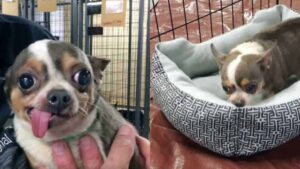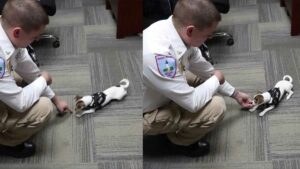“Dear Dr. Johns: My Chihuahuas knee issues have gotten out of hand. Both his caps are both out. They said they will not stay in. He is a little over 4 years old. How soon should I have the surgery done and do they do both knees at one time?”
Thank you, Mrs. Connie VanVekoven.
Dear Connie: The condition you describe is overrepresented in Chihuahuas along with many other very small-breed dogs.
When the knee cap rides out of the groove that it normally sits in, it is known as patellar luxation. The knee cap can luxate suddenly and painfully secondary to trauma, or, more commonly, it can be something that has evolved due to abnormal development of the bones and ligaments in the knee.
About Chihuauhas Knee Issues
The knee cap rests in a relatively deep groove over the femur, or thigh bone. It is held in place by ligaments that attach to the tibia or shin bone and the thigh bone. As the knee flexes and extends, tension from the ligaments pulls the knee cap evenly, allowing it to glide smoothly in the groove and rest in its proper position in the middle of the knee.
Dogs with patellar luxation typically have a shallow groove that the cap can easily migrate out of. The ligaments are either too loose or too tight, causing abnormal pull in one direction and causing the knee cap to veer off its normal path. The abnormal development can also involve the leg bones and hip joint, causing a marked “bow-legged” appearance when the knee cap luxates inwardly and a “knock-kneed” appearance when it luxates outward.
This condition is described as occurring in four stages. Stage one is not noticeable. The knee cap can be pushed out of the groove manually but it will pop back into place on its own. In stage two, the knee cap will come out on its own occasionally, but will pop back in easily. Stage three sees the knee cap staying out of its groove for longer periods of time that require manipulation to return it to its proper place.
Stage Four of Chihuahuas Knee Issues
In stage four, the knee cap stays out all the time. Whenever the knee cap is out of socket, usually the dog is leg carrying lame. In the early stages the owner may notice that the dog occasionally picks up its leg while running. Each time the knee cap goes out, it becomes easier and easier for it to luxate on its own. In other words, it’s just going to get worse.
Over time, the knee becomes very arthritic and the dog’s mobility and comfort are affected. Your dog must be in stage four if the knee caps won’t go back in. Surgery is recommended for any dog over stage two that is showing significant lameness. The sooner the surgery is done, the less arthritis the dog will have over its lifetime.
While it is possible to do both knees at once, I would not recommend it because of the seriousness of the surgery. This is major orthopedic procedure and the recovery period is a minimum of six weeks. Doing one leg gives the dog “a leg to stand on” while the surgical repair is healing.
Source: nwfdailynews
Image Credits: getty




